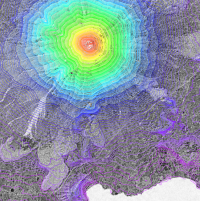Viewfinder Panoramas
Introduction
The Viewfinder Panoramas dataset is a digital elevation dataset with focus on the areas outside SRTM coverage. Also, the dataset has been focusing on fixing the voids in the SRTM dataset, e.g. by improving the DEM data in mountainous terrains. The dataset is developed by Jonathan de Ferranti and published on his website www.viewfinderpanoramas.org. Sources for the DEM models are typically Russian military maps in scales 1:100000 and 1:200000, but also other local and global sources are used, see the table below.
Availability from within WindPRO
The data is available directly from within WindPRO. The data can be reached from the online-services in the following objects:
- Line Object (with purpose to height contour lines)
- Elevation Grid Object
In addition to loading the data directly from the EMD online services, then WindPRO also supports importing the *.hgt files that can be downloaded from other internet sources.
Data Type
Raw data are stored in the HGT format, i.e. the same distribution format as the SRTM dataset.
Coverage
About 80% of the total landmass of the Earth is mapped by the STRM data, covering all land between 56 degrees south and 60 degrees northern latitude. A view of the data coverage is shown in the figure below.
Versions and Data Sources
Different versions of the SRTM data exist; at EMD we currently distribute the STRM data version 3.The difference between various versions is primarily that more error checking and validation is applied at later versions.
An alternative SRTM dataset with a higher spatial resolution of 1 arc second (about 30 m) is also available for the US and its territories. Currently this dataset is currently not available through the EMD online services, but it is possible to manually download the data and load the data into a line object.
External Links
- Original data is available from the NASA website at http://www2.jpl.nasa.gov/srtm.
- More information on SRTM is available at wikipedia at http://en.wikipedia.org/wiki/Shuttle_Radar_Topography_Mission
Acknowledgement
NASA, team around STS-99 and the US public are thanked for making this great digital elevation dataset available in the public domain and thus for aiding the development of renewable energy.

